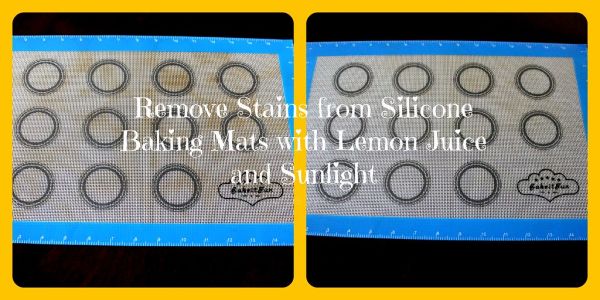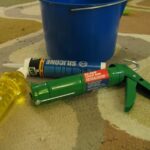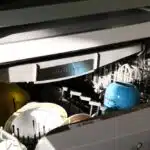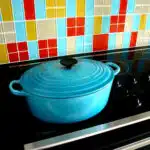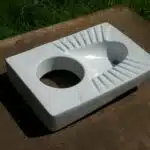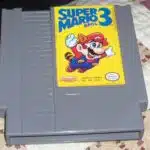Cleaning a silicone baking mat can be a daunting task, especially if you are not aware of the proper way to do it. A silicone baking mat is a must-have in every kitchen as it provides an easy and convenient way to bake your favorite treats without the need for parchment paper or cooking spray. However, after using it for some time, it can become sticky and discolored, making it less effective and unsanitary for use.
If you want to keep your silicone baking mat in good condition and ensure that it lasts for a long time, then regular cleaning is essential. In this article, we will discuss the best methods for cleaning a silicone baking mat effectively. As a professional cleaning expert, I’ve seen many people struggle with this task, but with the right tools and techniques, you can clean your baking mat quickly and easily. So let’s dive into the details and learn how to clean your silicone baking mat like a pro.
Gathering The Necessary Supplies
The silicone baking mat is a versatile kitchen tool that has grown in popularity in recent years. Its non-stick surface makes it easy to use and clean, which is why many bakers prefer it over traditional parchment paper. If you are new to using silicone baking mats, choosing the right one is crucial. Look for a mat that is FDA approved, heat-resistant up to at least 450°F, and can fit comfortably inside your oven.
Once you have found the right mat, it is important to store it properly when not in use. Best practices for mat storage include rolling the mat up instead of folding it, storing it flat or on its side in a dry place away from direct sunlight and heat sources. This will prevent the mat from becoming misshapen or damaged over time.
Properly caring for your silicone baking mat will extend its lifespan and ensure that it remains in good condition for years to come. In the next section, we will discuss how to prepare your mat for cleaning before diving into the actual cleaning process.
Preparing The Mat For Cleaning
- To begin the cleaning process, it is essential to first remove any food residue from the surface of the silicone baking mat.
- A pre-soak of the mat can help to loosen any baked-on food particles before scrubbing.
- Hot water and a mild soap solution should be used to pre-soak the mat, as harsher chemicals may damage the silicone.
- After the pre-soak, the mat should be gently scrubbed with a soft brush or sponge to remove the food residue.
Remove Food Residue
When it comes to cleaning a silicone baking mat, removing food residue is the first step in preparing the mat for a thorough cleanse. Before scrubbing techniques can be employed, it’s important to remove any remaining food particles. This can be done by gently scraping off any large pieces using a plastic spatula or scraper. Take care not to use anything too abrasive as this could damage the surface of the mat.
To tackle any stubborn food residue, scrubbing techniques may be required. Begin by filling a sink or basin with warm water and adding a small amount of dish soap. Place the mat in the water and allow it to soak for several minutes before using a soft-bristled brush or sponge to gently scrub away any remaining food particles. Take care not to use anything too harsh as this could cause damage to the mat’s surface.
Preventative measures can also be taken to make future cleaning easier and more effective. Before each use, it’s recommended that you lightly coat your silicone baking mat with cooking spray or oil spray. This will help prevent food from sticking and make it easier to clean up after each use. Additionally, avoid using sharp knives or utensils on your silicone baking mat as these can cause scratches and damage that will make cleaning more difficult over time. By taking these simple steps, you’ll be able to keep your silicone baking mats in great condition for years to come!
Pre-Soak Mat
When it comes to preparing a silicone baking mat for cleaning, there are several steps that should be followed to ensure a thorough and effective cleanse. In addition to removing any food residue, it’s important to pre-soak the mat before scrubbing away any remaining particles. Pre-soaking can help loosen stubborn residue and make it easier to remove during the cleaning process.
One of the benefits of using a silicone baking mat is its non-stick surface, which can make cleaning up after cooking a breeze. However, even with this feature, food residue can still build up over time and require some extra attention. To prepare the mat for cleaning, start by filling a sink or basin with warm water and dish soap. Place the mat in the water and allow it to soak for several minutes before proceeding with scrubbing techniques.
During the pre-soaking process, you may notice that some of the food particles begin to float off of the mat’s surface. This is a good sign that your pre-soak is working effectively! After soaking, use a soft-bristled brush or sponge to gently scrub away any remaining residue. By taking these steps, you’ll be able to keep your silicone baking mat in great condition and avoid having to resort to alternative materials like parchment paper or aluminum foil.
Using Soap And Water
To clean a silicone baking mat, using soap and water is one of the most effective methods. It is a simple process that can be done by anyone without any cleaning hacks or special tools. All you need is mild dish soap, warm water, and a soft sponge.
Firstly, rinse the mat under running water to remove any loose debris or crumbs. Then apply a small amount of dish soap onto the mat and use the damp sponge to scrub it gently in circular motions. Be sure to apply enough pressure to remove any stubborn stains but not too much that you damage the surface of the mat. Rinse off with warm water and wipe dry with a clean towel.
If you encounter tough stains on your silicone baking mat, there are alternative methods that you can use alongside soap and water. Adding baking soda to your cleaning solution can help loosen up stubborn stains and make them easier to scrub off. We will discuss this method in detail in the next section. With these simple cleaning steps, your silicone baking mats will remain in pristine condition for years to come!
Adding Baking Soda For Tough Stains
For tough stains on your silicone baking mat, adding baking soda to your cleaning mixture can help. Baking soda is a natural abrasive that can gently scrub away stubborn residues without damaging the surface of your mat. To use baking soda for cleaning, first sprinkle a light layer over the affected area, then add warm water and dish soap. Use a soft-bristled brush or sponge to gently scrub the stain in circular motions until it lifts away.
While silicone baking mats are known for their non-stick properties, they may still develop stains or discoloration over time. Using baking soda not only helps to remove these unsightly marks but also leaves your mat looking and smelling fresh. Additionally, silicone mats have several benefits over traditional parchment paper or greased pans. They are reusable, eco-friendly alternatives that reduce waste and save money in the long run. Silicone mats also distribute heat evenly throughout your baked goods for consistent results every time.
If you prefer not to use baking soda for cleaning, there are other options available. White vinegar is another natural cleaning agent that can remove tough stains while deodorizing your mat at the same time. Simply mix equal parts white vinegar and warm water in a spray bottle and spritz onto your mat before wiping clean with a damp cloth. Whatever method you choose, remember to rinse your silicone mat thoroughly with warm water and dry completely before storing away until next use.
Creating A Vinegar Solution
Creating a Vinegar Solution:
Vinegar is an all-natural and cost-effective solution for cleaning silicone baking mats. It’s perfect for removing stains, grease, and any unpleasant odors that may linger on the mat. The benefits of using vinegar include its antibacterial properties, making it a safe option for cleaning surfaces where food is prepared.
To create a vinegar solution, mix equal parts of white vinegar and water in a bowl or spray bottle. This mixture can be applied to the silicone baking mat either with a cloth or by spraying directly onto the surface. Allow the solution to sit on the mat for 10-15 minutes before wiping it clean with a damp cloth. Remember to rinse off any remaining vinegar with warm water and dry thoroughly.
Alternatives to vinegar include baking soda and lemon juice solutions. However, it’s important to note that these alternatives may not have as powerful antibacterial properties as vinegar. Baking soda can be mixed with water to make a paste that can be applied directly onto tough stains. Lemon juice can be combined with warm water in a spray bottle and applied similarly to the vinegar solution. Regardless of which alternative you choose, never mix them together as they may react negatively with each other.
Transition: Now that we’ve discussed creating a vinegar solution for cleaning your silicone baking mats let’s move on to another alternative – applying lemon juice.
Applying Lemon Juice
After creating a vinegar solution, it’s time to tackle the next step in cleaning your silicone baking mat. While some may suggest using dish soap or rubbing alcohol, we’ll be exploring the benefits of using baking powder. Yes, that same ingredient that gives your cakes and pastries their fluffy texture can also be used for cleaning!
To start, sprinkle a generous amount of baking powder onto your silicone baking mat. Using a damp cloth or sponge, gently scrub the mat in circular motions. Baking powder is a gentle abrasive that effectively removes any remaining stains and odors on the surface of the mat.
After scrubbing for a few minutes, rinse the mat with warm water to remove any excess baking powder. You should notice an immediate difference in the appearance and smell of your silicone baking mat. If there are still stubborn stains remaining, repeat this process until they disappear completely. Now that you’ve successfully cleaned your silicone baking mat with vinegar and baking powder, let’s move on to our next method: Using hydrogen peroxide.
Using Hydrogen Peroxide
Hydrogen peroxide is a powerful cleaning agent that can be used to clean a variety of surfaces, including silicone baking mats. One of the benefits of using hydrogen peroxide is that it is a natural disinfectant, meaning that it can kill bacteria and other harmful microorganisms on your baking mat. To use hydrogen peroxide to clean your silicone baking mat, simply mix equal parts hydrogen peroxide and water in a spray bottle and spray the solution onto the mat. Let the solution sit for several minutes before wiping it away with a damp cloth.
If you prefer not to use hydrogen peroxide, there are several alternatives that you can try. One option is to use white vinegar, which is also a natural disinfectant. Simply mix equal parts white vinegar and water in a spray bottle and spray the solution onto the mat. Another option is to use baking soda, which can help remove stubborn stains and odors from your silicone baking mat. Sprinkle baking soda onto the mat, let it sit for several minutes, and then wipe it away with a damp cloth.
While hydrogen peroxide is an effective cleaning agent for silicone baking mats, it may not be suitable for all types of mats or for those with sensitive skin or respiratory issues. If you have concerns about using hydrogen peroxide or if you experience any discomfort while cleaning your baking mat with this solution, consider trying rubbing alcohol instead. This alternative will be discussed in further detail in the subsequent section.
Trying Rubbing Alcohol
Rubbing alcohol is another effective method for cleaning silicone baking mats. This solution can be used in conjunction with warm water and soap to remove any stubborn stains or residue left behind after use. To begin, mix equal parts rubbing alcohol and warm water in a spray bottle. Spray the solution onto the mat, making sure to cover the entire surface area.
Using a soft-bristled brush, gently scrub the mat in circular motions until all visible stains and residue have been removed. Rinse the mat thoroughly with warm water to remove any leftover solution. Allow the mat to dry completely before storing it away.
Alternative methods for cleaning silicone baking mats include using vinegar or baking soda solutions, as well as placing them in the freezer overnight to loosen any debris before wiping them clean. However, it’s important to note that these methods may not be as effective as using rubbing alcohol and could potentially damage the mat over time if used too frequently. It’s always best to follow manufacturer guidelines for cleaning and maintenance of your particular silicone baking mat model.
Transition: While hand washing with rubbing alcohol is an effective method for cleaning silicone baking mats, there are other options available such as using a dishwasher which we will explore next.
Using A Dishwasher
- When loading the dishwasher, it is important to check for any food remnants on the silicone baking mat and clean accordingly before placing it in the dishwasher.
- When running the dishwasher, ensure the setting is on a gentle cycle to avoid any damage to the silicone baking mat.
- For optimal cleaning results, use a dishwasher-safe detergent when running the dishwasher.
- When cleaning the dishwasher, it is essential to check the water temperature is not too hot to avoid damage to the silicone baking mat.
- In order to prevent the buildup of bacteria, wipe down the interior of the dishwasher after every use.
- To prolong the life of the silicone baking mat, use a soft cloth and non-abrasive cleaner to clean it after each use.
Loading The Dishwasher
When it comes to using a dishwasher for cleaning your dishes, loading them properly is crucial for achieving the best results. There are both pros and cons to using a dishwasher, but as long as you follow the best practices for loading it, you can ensure that your dishes come out clean and hygienic every time.
One of the main things to consider when loading a dishwasher is the placement of your dishes. You should always load plates and bowls facing towards the center of the machine, while glasses and cups should be loaded upside down on the top shelf. Additionally, silverware should be placed in its own designated basket or tray to avoid any damage to other items in the machine. By following these best practices, you can help ensure that all surfaces of your dishes are exposed to water and detergent during the wash cycle.
Another important consideration when loading a dishwasher is how much space you leave between each dish. While it may be tempting to cram as many dishes into one load as possible, doing so can actually prevent them from getting cleaned properly. Make sure there is enough space between each item so that water can flow freely around them during the wash cycle. This will help ensure that every dish comes out looking spotless and hygienic, while also prolonging the life of your machine.
In conclusion, loading a dishwasher properly is an essential step in ensuring that your dishes come out clean and hygienic every time. By following these best practices, you can make sure that all surfaces of your dishes are exposed to water and detergent during the wash cycle while also prolonging the life of your machine. With a little bit of care and attention, anyone can become an expert at loading their dishwasher like a pro!
Running The Dishwasher
After properly loading the dishwasher, the next step is to actually run it. However, there are certain things that should be taken into consideration when running a dishwasher to ensure that it functions optimally. One of these considerations is selecting the right cycle and temperature for your dishes. Some dishwashers have eco-friendly options that use less water and energy, which can help reduce your carbon footprint while still getting your dishes clean.
Another important factor to consider when running a dishwasher is whether or not to use high heat. While high heat can help sanitize dishes and remove tough stains, it also requires more energy and can potentially damage delicate items. It’s important to weigh the pros and cons of using high heat before deciding whether or not to select this option on your dishwasher.
Once you’ve selected the appropriate cycle and temperature for your dishes, it’s time to start the dishwasher. Make sure that all items are securely in place before closing the door and starting the machine. Most dishwashers have an indicator light or beep that signals when the cycle is complete, at which point you can open the door and unload your clean dishes. By following these simple steps, you can ensure that your dishwasher runs smoothly and effectively every time you use it.
Cleaning The Dishwasher
Properly using a dishwasher not only involves loading and running it, but also cleaning it regularly. A clean dishwasher not only ensures that your dishes are being properly sanitized, but also extends the lifespan of your machine. One effective way to keep your dishwasher clean is by using silicone mats.
Benefits of silicone mats include their ability to catch food particles and prevent them from clogging the dishwasher drain. They can also protect delicate items from getting scratched or damaged during the washing process. When choosing a high quality mat, look for one that is heat-resistant and durable enough to withstand frequent use.
To effectively clean your dishwasher with silicone mats, start by removing any visible debris or buildup from the bottom of the machine. Then, place the mats on the bottom rack of the dishwasher and run a cycle with hot water and vinegar. This will help remove any remaining buildup and leave your dishwasher looking and smelling fresh. By incorporating these tips into your dishwashing routine, you can ensure that both your dishes and dishwasher are always sparkling clean.
Avoiding Harsh Chemicals
Cleaning your silicone baking mat doesn’t have to involve harsh chemicals. In fact, there are many eco-friendly alternatives and natural cleaning solutions that can give you the same results without posing a threat to your health or the environment. As a professional cleaning expert, I highly recommend exploring these options.
One of the most effective eco-friendly alternatives for cleaning your silicone baking mat is using vinegar and baking soda. Simply mix equal parts of vinegar and water in a spray bottle and apply it generously on the mat. Then sprinkle some baking soda onto the surface and let it sit for about 10 minutes. Finally, rinse off with warm water and let dry. This simple solution not only cleans but also deodorizes the mat.
Another natural cleaning solution that works wonders on silicone baking mats is lemon juice. The acidity in lemon juice helps to break down any residue or stains on the surface, leaving it clean and fresh-smelling. To use this method, simply cut a lemon in half, squeeze out the juice onto the mat, and use a soft brush to scrub gently. Rinse thoroughly with warm water and let dry.
Now that you know some eco-friendly alternatives and natural cleaning solutions for your silicone baking mats, you can clean them effectively without worrying about using harsh chemicals. But before you start using your mat again, make sure it’s completely dry to prevent any mildew or mold from forming. To do this, lay it flat on a dry towel or hang it up to air-dry naturally. With these tips in mind, you can keep your silicone baking mats looking like new for years to come!
Drying The Mat
Air drying a silicone baking mat is a simple process that requires no special materials. To air dry a silicone baking mat, simply leave it to dry on a counter or other flat surface. Towel drying a silicone baking mat is a slightly more involved process but still very simple. To towel dry a silicone baking mat, first pat it dry with a clean, absorbent cloth and then allow it to air dry. Hang drying a silicone baking mat is a great alternative for those with limited counter space. To hang dry a silicone baking mat, simply hang it from a clothesline or other hanging device. All three methods of drying a silicone baking mat are equally effective and provide a clean, hygienic surface for baking. With proper care, a silicone baking mat can last for many years.
Air Dry
When it comes to drying a silicone baking mat, air drying is the best way to go. Using heat to dry the mat can cause damage and may even melt the silicone material. Therefore, it is important to let the mat dry on its own after cleaning.
Air drying ensures that no moisture is left on the mat, which in turn prevents mold from growing. Moisture can get trapped between folds or creases of the mat if it is not dried properly. This can lead to an unpleasant smell and potentially harmful mold growth. By allowing your silicone baking mat to air dry completely, you eliminate any risk of mold formation.
To air dry your silicone baking mat, simply lay it flat on a clean surface and leave it until it is completely dry. It may take several hours for the mat to fully dry depending on the level of humidity in your home. Once it is dry, you can safely store it away until its next use. By following these simple steps, you ensure that your silicone baking mat stays clean and free from mold or damage caused by excessive heat.
Towel Dry
Another option for drying a silicone baking mat is towel drying. This method involves using a clean and dry towel to remove excess moisture from the mat after washing it. Towel drying can speed up the drying process, especially if you need to use the mat again soon after cleaning it.
To towel dry your silicone baking mat, first wash it with soap and water or place it in the washing machine. Once you have finished washing the mat, gently pat it dry with a clean and absorbent towel. Avoid rubbing the mat vigorously as this may damage its surface.
After towel drying, allow the mat to air dry completely before storing it away. While towel drying can remove most of the moisture from the mat, there may still be some remaining moisture that needs to evaporate. By leaving the mat out to air dry, you ensure that all moisture is eliminated and that mold does not grow on your silicone baking mat.
Hang Dry
When it comes to drying a silicone baking mat, there are different methods you can use. One of these methods is hang drying. This involves hanging the mat up to dry in a well-ventilated area after washing it with soap and water or placing it in the washing machine. Hang drying allows air to circulate around the mat, which can speed up the drying process and ensure that all moisture is eliminated.
To hang dry your silicone baking mat, first wash it with soap and water or place it in the washing machine. Once you have finished washing the mat, shake off any excess water and hang it up using a clothes hanger or by draping it over a clean surface. Make sure to choose a well-ventilated area for hanging the mat, such as near an open window or outside on a clothesline.
After hang drying, allow the mat to air dry completely before storing it away. This will ensure that all moisture has been eliminated from the mat and that mold does not grow on its surface. While towel drying can remove most of the moisture from the mat, hang drying allows for better air circulation and can be more effective in ensuring that your silicone baking mat is completely dry before its next use.
Storing The Mat Properly
Proper storage of your silicone baking mat is crucial for avoiding damage and ensuring it lasts as long as possible. The best way to store a silicone baking mat is by rolling it up and securing it with a rubber band or string. This will prevent the mat from bending or creasing, which can cause damage over time.
Before storing your silicone baking mat, make sure it is completely dry. Any moisture left on the mat can lead to mold or mildew growth, which can be difficult to remove. If you are short on time and need to use your mat again soon after cleaning, you can quickly dry it by wiping it down with a clean towel or placing it in a warm oven for a few minutes.
Avoid storing your silicone baking mat near sharp objects, such as knives or metal utensils, as they can puncture or scratch the surface. Additionally, keep the mat away from direct sunlight and heat sources, such as stovetops and ovens, which can cause warping or melting. By following these simple storage guidelines, you can ensure that your silicone baking mat stays in excellent condition for years to come.
Transition: Now that you know how to properly store your silicone baking mat, the next step is learning how to maintain its cleanliness. Here are some tips for keeping your mat spotless and ready for every baking adventure!
Tips For Maintaining A Clean Mat
After cleaning your silicone baking mat, it is important to take preventive measures to maintain its cleanliness. A simple wipe down with a damp cloth after each use can go a long way in preventing buildup and stains. Additionally, avoid using sharp utensils on the mat as this can cause scratches which can trap food particles and lead to bacteria growth.
There are also common mistakes that should be avoided when cleaning a silicone baking mat. One such mistake is using harsh detergents or abrasive sponges which can damage the surface of the mat and reduce its lifespan. Another mistake is placing the mat in the dishwasher as high heat can warp the material.
To ensure your silicone baking mat lasts for years to come, consider implementing these 3 tips:
- Store your mat flat or rolled up instead of folded to prevent creases and cracks.
- Use baking soda and vinegar for tough stains instead of harsh chemicals.
- Rotate between two mats so one can be washed while the other is being used.
When faced with common issues such as discoloration or residue buildup, don’t panic! Troubleshooting these problems is easy and can often be done with ingredients already found in your kitchen.
Troubleshooting Common Issues
After reading the previous section, you may be feeling confident about your ability to maintain a clean mat. However, even with proper care and attention, issues can still arise. Don’t worry – we’ve got you covered with some tips for troubleshooting common problems.
Preventing damage is key when it comes to long term maintenance of your silicone baking mat. Avoid using sharp objects such as knives or scissors on the mat as they can cause cuts or tears which will compromise its effectiveness. Additionally, try to avoid exposing the mat to extreme temperatures – this means avoiding broilers and open flames.
If your mat has become discolored or stained, don’t fret! One solution is to soak the mat in warm water and dish soap for about 15 minutes before scrubbing gently with a soft-bristled brush. For more stubborn stains, you can try using baking soda and vinegar to create a paste which can be applied directly to the affected area. Allow the paste to sit for a few minutes before wiping away with a damp cloth. Remember – always air dry your silicone baking mat after cleaning it and store it flat or rolled up rather than folded.
Frequently Asked Questions
Cleaning a silicone baking mat is an important part of maintaining its quality and durability. Regular cleaning helps to remove food debris, grease, and stains that accumulate over time. The frequency of cleaning depends on how often the mat is used. For frequent bakers who use their mats daily, it is recommended to clean them after every use. For occasional bakers, cleaning the mat once a week should suffice.
To clean a silicone baking mat, there are several methods you can choose from. The most common method involves using warm soapy water and a soft sponge or brush to gently scrub the surface of the mat. Rinse well with water and hang to air dry. Another alternative cleaning method involves placing the mat in the dishwasher on the top rack with other kitchen utensils.
For tougher stains or baked-on residue, you can try using baking soda and vinegar to create a paste that will help break down any stubborn stains. Apply the paste onto the stained area and let it sit for 5-10 minutes before wiping it away with a damp cloth or sponge. Avoid using abrasive cleaners or scouring pads which can scratch or damage the surface of your silicone baking mat.
Regular cleaning is essential for maintaining your silicone baking mat’s quality and ensuring that it lasts for many years to come. By following these simple cleaning tips, you can keep your mat looking clean and pristine while also preventing any unwanted odors or bacteria buildup from occurring over time.
Conclusion
Cleaning a silicone baking mat is an essential task for any kitchen enthusiast, and it requires proper care to ensure longevity and functionality. By following the steps outlined above, you can keep your mat clean and in pristine condition for years to come.
When preparing to clean your silicone baking mat, be sure to gather all the necessary supplies, including soap, water, baking soda, and vinegar solution. Additionally, take note of any tough stains that may require extra attention. Adding baking soda to your cleaning routine can help tackle those pesky stains effectively.
Creating a vinegar solution is another effective way to clean your silicone baking mat thoroughly. Once you have completed the cleaning process, store your mat properly in a cool, dry place away from direct sunlight. By incorporating these tips into your regular cleaning routine and troubleshooting common issues before they become bigger problems, you can maintain a clean and functional silicone baking mat with ease. As a professional cleaning expert: keep calm and bake on!
Image Credits
- “silicone baking mat stain remover tip” by www.homejobsbymom.com (featured)

